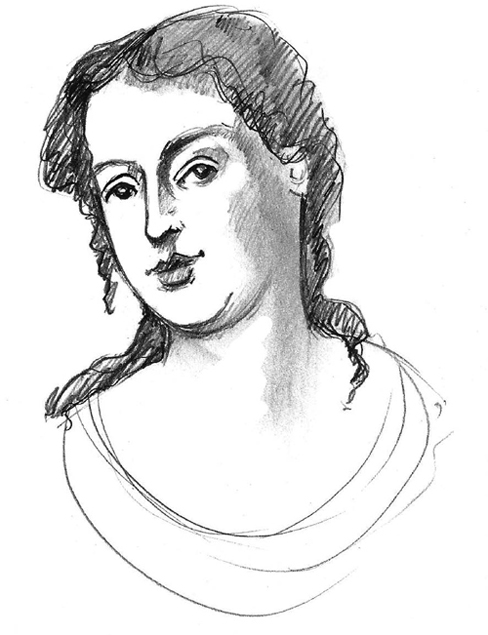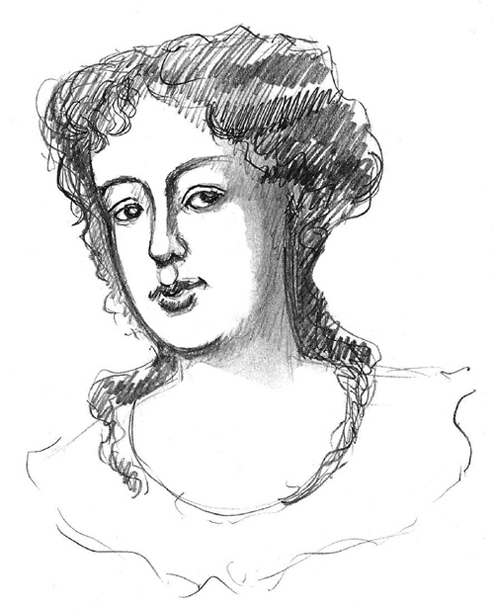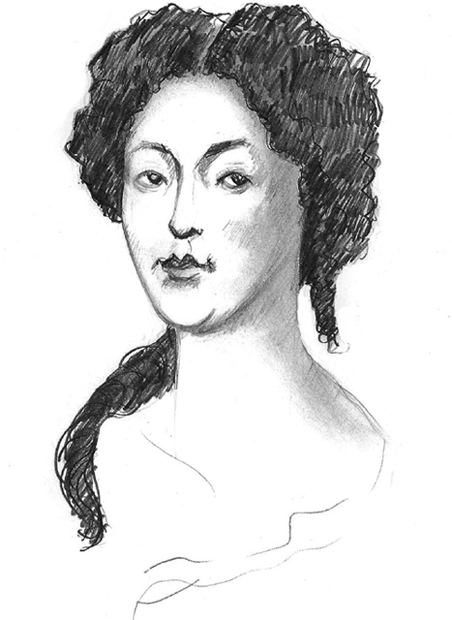Other Women (5 page)
Authors: Fiona McDonald

Charles II was a frequent theatregoer and it is likely that it was there that he first became acquainted with Moll. They began their affair in 1667 and Moll retired from the stage a year later. In 1669 Moll gave birth to a girl, Mary Tudor. The relationship between the king and Moll was not a long one. While she was one of his favourites she was showered with money and jewels, housed sumptuously, even sporting her own coach. A comfortable house full of furniture was provided for her in a street belonging to a nephew of Moll’s father.
Why she fell out of favour is not really known, but it is popularly attributed to a rather nasty trick supposedly played on her by her rival, the actress Nell Gwyn. The story goes that Nell understood Moll was going to spend the night with the king so, in a fit of jealousy, laced Moll’s food with jalap, well known for its laxative effects. Moll was not well that night and the symptoms put a halt to any thoughts of lovemaking.
Moll was well provided for even though she was no longer part of the king’s retinue. She was given a lifelong annuity of £1,000 (around £83,000 today) and was able to retain her house. In 1673 Moll sold up and bought a large house in St James’s Square for £1,800. Over ten years later she took her new husband, the composer James Paisible, to live in this house. Moll died in 1708.

Moll Davis
’Pretty, witty Nell’ (1650–1687), as Samuel Pepys called her, was born in very low social circumstances, perhaps in Hereford, perhaps in Oxford, but more probably in Covent Garden, London. Her father may have been Captain Thomas Gwyn, a Royalist soldier, although this story was not popularly believed at the time. Nell’s mother, on the other hand, was notorious as a vulgar, drunk madam of a brothel. Nell also had a sister, Rose. In 1663, Rose Gwyn was locked up in Newgate Prison on a charge of theft. She petitioned Harry Killigrew, son of the owner of the King’s Theatre, to get her a pardon.
Nell and her sister worked first for their mother. It is rumoured that the girls both worked as prostitutes in their mother’s brothel, although Nell later strenuously denied this. A new theatre was opened close to where the girls lived – The Theatre in Bridges Street – and Nell and Rose went to work for a former prostitute, Mary Meggs (known as Orange Moll) selling oranges, sweetmeats and other treats to theatregoers. It was in this capacity that Nell and her sister became acquainted with the theatre and acting.
At age 14 Nell, almost completely illiterate, began to take on small roles on stage. To see if she could live up to her promise, she attended acting classes conducted by Thomas Killigrew, who led the King’s Company of players, and one of his leading actors, Charles Hart. Dancing was taught by John Lacy.
The parts Nell played grew more important and complex. The first documented evidence of Nell performing in a major role is in 1665. It was a play by Dryden, and Nell was given a serious part to play, though Pepys noted in his diary that she played it poorly. Nell admitted that she was much better at playing comic characters and it was in another play later in the same year that she starred in a comedy by James Howard,
All Mistaken, or the Mad Couple
. The actor Charles Hart played her onstage lover, a role that he was only too happy to continue in their private lives. The play was a success and the making of Nell as an actress.

Nell Gwyn
Nell’s brilliant debut was cut short by the Great Plague, which saw all public places such as theatres being closed down to help stop the spread of the disease. Nell, her mother and a number of other actors and actresses left London for Oxford, along with the king’s court. Charles II could not live without his entertainment and he had the players put on pieces for the court. The performers were granted the right to wear the king’s livery and therefore be counted as his servants.
When the threat of the Plague was over, the theatre reopened and Nell continued her new and popular comic role as one half of a ‘gay couple’ (taking that word in its original sense). At this time Nell was having an amorous affair with Charles Sackville, Lord Buckhurst. The pair went on holiday to Epsom and Nell was supposed to have been paid an allowance by her lover of £100 (around £8,300) a year.
It wasn’t until 1668 that Nell became a close part of Charles II’s life. Charles was well acquainted with Nell as a performer but he got to know her more intimately when she sat in a theatre box beside his. They flirted throughout the performance and afterwards dined with Mr Villiers at a local coffee house. The story goes that when the bill had to be paid neither the king nor Mr Villiers had the cash to do so and Nell had to cover the cost for them all. Needless to say, she was a trifle underwhelmed but came up with a suitable sharp quip for the occasion.
It was not long after this episode that Nell was acknowledged at court as the king’s mistress. She referred to her latest lover as Charles III because she had already had a fling with Charles Hart and then Charles Sackville, therefore the king had to be Charles III. Nell was determined to be faithful to her lover; she knew (although she didn’t like it) that he would have more than one mistress at a time but she swore fidelity to him. It rankled that she had a rival in Moll Davis, and Nell supposedly helped Moll to fall out of favour (via her little trick with the purgative and the sweetmeats, as previously described).
Being the lover of a monarch did not prevent Nell from staying on the stage. She did take a break in 1670 for the birth of her first child, Charles Beauclerk, fathered by the king.
Nell might have been taken care of but the king soon brought in a new lady, Louise de Kérouaille. This French lass had a slight cast to one eye and Nell unkindly called her Squintabella. Perhaps it was to show the king her independence that Nell returned to the stage in 1671 for one more season, at the grand old age of 21. And maybe it was to appease her that he had her lodged in a townhouse close to the court. There must have been a reconciliation that year because Nell gave birth to a second boy, James.
One of the most appealing things about Nell Gwyn was her working-class background. She was the darling of the people because she represented them in her Englishness and her lack of aristocratic breeding. Nell had no airs whatsoever. She also had a ready repartee to protect herself from slights and insults, and was always happy to make fun of those whom she thought deserved it, drawing on her comic acting genius in which to do so.
Nell was not greedy for wealth and she did not want titles for herself, but she certainly felt that her two children deserved to have the same as the king’s other bastards had: acknowledgement of their royal birth by means of titles and land. It was also not fair, she said, that because she was a commoner her house was only leased for her; she should be entitled to own it as other mistresses had before her. In 1676 the freehold on her house was granted to her and her sons were given titles: Charles was given the Earl of Burford and James, Lord Beauclerc. Little James didn’t live to understand the full impact that his title would have given him. In 1671, while at school in Paris, he suddenly died. Nothing is known of the incident, although it was noted at the time that he had died of ‘a sore leg’. Charles, on the other hand, was made Duke of St Albans in 1684 and made Chief Ranger of Enfield Chase and Master of Hawks, to be taken up when the positions next became vacant. The youth was also given a yearly allowance of £1,000.
The following year Charles II lay dying. He called his brother James to hear his last wishes. These included ongoing welfare for Barbara Palmer, Louise Kérouaille and Nell Gwyn. The king’s words were recorded as being ‘Let not poor Nelly starve’.
James probably wanted to put his brother’s former lovers into a sack and throw them into the River Thames, but he did eventually put the requests into action. Nell was given £1,500 a year and her debts and mortgages were all paid off.
Nell Gwyn did not survive her Charles III by more than two years. She had a stroke in March 1687 followed by another in May. She died in November of that same year. The supposition is that she had a form of syphilis. Nell was not able to live within the means of her pension and when she died she had as many debts as ever. However, she managed to leave a bequest to the inmates of Newgate Prison to help ease their lives there.
Louise de Kérouaille (1649–1734) was born to an aristocratic couple from Brittany. It is said that the family name, Kérouaille, was taken from a female ancestor who had married François de Penhoët in 1330.
As a girl Louise was sent to live with the family of Charles II’s youngest sister, Henrietta Anne Stuart, the Duchess d’Orléans, married to the brother of Louis XIV. Louise accompanied Henrietta Anne on her trip back to England to visit Charles in 1670. Apparently Charles asked his sister if he could keep Louise for himself, but she told him the girl had been entrusted to her care and that the family would be expecting her to be looked after. There are rumours that Louise’s family in fact sent her into the duchess’s household in order that she be thrown in the way of a king, French or English, with a view to becoming the mistress of one of them.
The Duchess d’Orléans died of a sudden and violent illness a few days after her return to France. It was thought at first to have been caused by poison but has since been determined that a duodenal ulcer resulted in acute peritonitis and it was this that caused the intense pain that accompanied her death. Louise was in need of a home and employment and it was thought an excellent idea that she be offered to Charles II’s wife, Catherine of Braganza, as a lady-in-waiting. Everyone knew what this really meant; a delicate morsel for the king himself. If there was any hint of Louise being a sacrificial lamb sent to the King of England as a means of keeping track of events, then she went with a willing spirit.
It did not take long for Louise to become a great favourite of Charles II both in and out of bed. Nell Gwyn did not like her and nor did the English people. It was not just that Louise was so obviously French, but that she was greedy for money and made sure she was kept well supplied with it. Louise’s son with the king, another Charles, was made Duke of Richmond when he was 3 years old.

Louise de Kérouaille
Louise was given various titles: Baroness Petersfield, Countess of Fareham and Duchess of Portsmouth. She also received the whacking great sum of £27,300. No wonder poor Nell was not pleased (though to be fair Charles did spend close to £60,000 on her over a three-year period).
Although Louise was Catholic she did not suffer the same fate as befell Barbara Palmer when the 1676 act was brought in preventing Catholics from holding any form of office within the royal household. This was because the queen intervened and had Louise made a member of her staff, who were exempt. Catherine, who had so hated Barbara Palmer, was more inclined to like Louise, who treated her with respect and was companionable. The queen may not have liked how her husband lived but she learned to put up with it as best she could.
Louise was with Charles when he died. She had been his constant companion throughout his illness and brought him solace at the end of his life, also insisting that he receive confession and absolution from a Catholic priest before he died.
